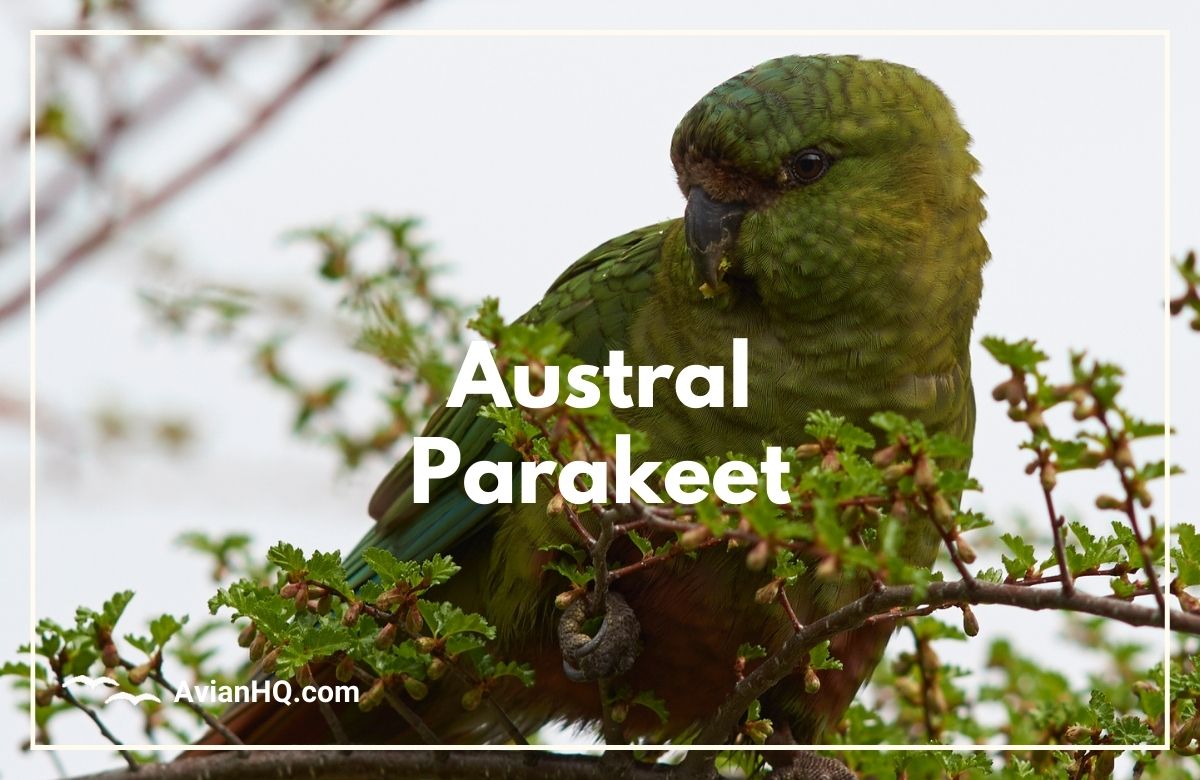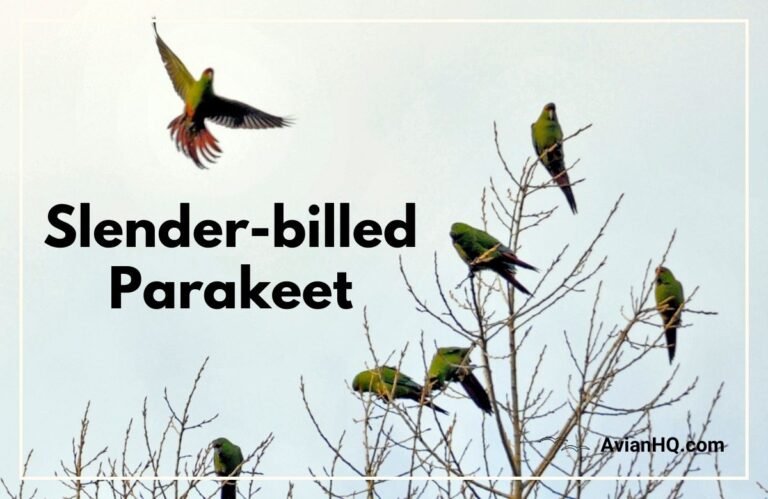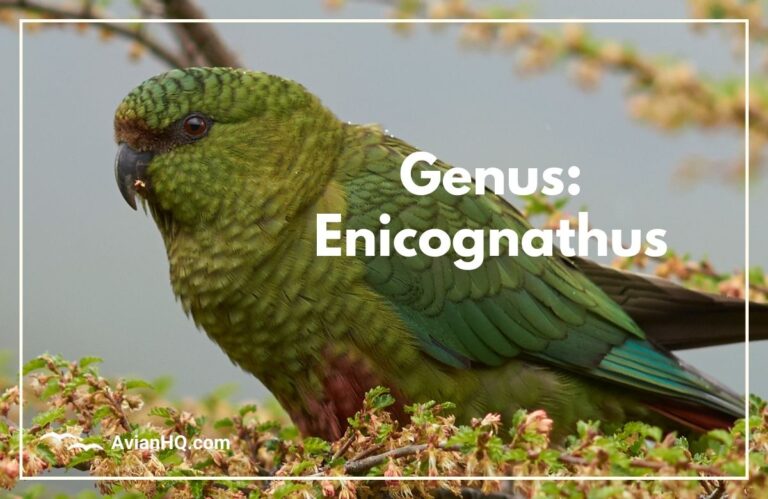Austral Parakeet (Enicognathus ferrugineus)
You first catch sight of the Austral Parakeet while hiking through the dense, humid forests of southern Chile. A flash of bright red and yellow darts past, accompanied by a shrill series of squawks. Measuring just 7 to 8 inches (18 to 20 centimeters) long, this vibrant bird is easy to overlook among the lush green foliage. But its colorful plumage and loud vocalizations give it away.
This small parrot is known as Enicognathus ferrugineus, bearing the scientific name that describes some of its key features. Enicognathus refers to the distinctive shape of its beak, slightly curved to allow it to easily crack seeds and nuts. Ferrugineus calls out its rusty red feathers, contrasted by bright golden hues underneath its wings.
The Austral Parakeet only resides within the temperate rainforests of Chile and bordering areas of Argentina. As you begin to learn more about this species through its history, physical attributes, habitat, and more, you’ll uncover the threats it faces from deforestation, climate change, and more. Though still relatively abundant across its range, the Austral Parakeet reminds us of rainforests’ incredible yet fragile native biodiversity.
History and Taxonomy
The vibrant red plumage of the Austral Parakeet first caught the attention of early European explorers and naturalists in South America. In 1828, the French naturalist René Primevère Lesson formally identified the species for science, categorizing it within the broader group of parakeets.
Lesson gave the Austral Parakeet the scientific name Psittacus ferrugineus, placing it within the Psittacus genus that contains many true parrots. As scientists studied the species further over the next decades, they noted distinctions in its physical characteristics and behaviors that set it apart from other parakeets.
In 1905, British zoologist Sir Walter Rothschild reclassified the Austral Parakeet, reassigning the species to its current designation as Enicognathus ferrugineus. The Enicognathus genus contains just three species, all smaller parakeets of temperate forest regions in southern South America. Though the early taxonomy placed the Austral Parakeet alongside much larger and more tropical parrots, Rothschild’s adjustments better capture its relationships with its closest relatives.
Physical Appearance
The Austral Parakeet is a colorful bird, with shades of red, yellow, green, and blue across its plumage. It reaches lengths between 7 to 8 inches (18 to 20 centimeters), with a wingspan of up to 12 inches (30 centimeters).
The most striking feature of its appearance is the bright red patch that covers the forehead, crown, nape, and cheeks of the male. Females display a similar vibrant red coloration, though slightly duller in hue and restricted only to the forehead and crown rather than entire head. Both sexes also bear blue edging on their wings and greenish-yellow feathers on the back and rump.
Underneath the wings, a vivid golden yellow bar runs across the coverts, contrasted by blue flight feathers. From below, this flashing of yellow and blue with each wing beat makes the parakeet visible even from afar. The long pointed tail feathers are olive green with blue tips. The eyes are brown, and the thick curved beak is grayish-black, suited to cracking hard nuts and seeds.
Juvenile birds hatch with mostly green and yellow downy feathers, and acquire their colorful adult plumage after their first molt at around 4 months old. Compared to related parakeet species, the Austral Parakeet is relatively stocky in build, with a short tail and wings and a loud, shrieking call. These adaptations suit its habitat among dense, humid forest canopies.
Habitat and Distribution
The Austral Parakeet resides exclusively in the lush temperate rainforests of central and southern Chile and neighboring western Argentina. Its range spans approximately 500 miles (800 kilometers) from Maule in central Chile down to Chiloé Island and adjoining forests and woodlands further south.
It lives year-round across this region between sea level up to altitudes of 3,000 feet (900 meters). The parakeets prefer lower mountain slopes and valleys with dense, mature stands of evergreen trees. Common native trees include the Chilean Podocarp, Chilean laurel, and Winter’s Bark.
The temperate climate of its native range brings humid, rainy weather for much of the year interspersed with drier summer months. Annual rainfall averages 40 to 100 inches (100 to 250 centimeters) across most of the range. The parakeets remain widely distributed across suitable forest habitats within this zone, though some localized populations show evidence of decline.
Exact current population sizes are unknown, but based on density estimates experts suggest there are likely over 50,000 and potentially up to 200,000 total Austral Parakeets remaining. Protecting these scattered forest ecosystems remains crucial to preserving a home for this colorful species.
Diet and Feeding
The diet of the Austral Parakeet consists primarily of seeds, nuts, berries, and some insects. Its thick, hooked upper beak and tongue are adapted to crack hard shells and access the nutritious kernels inside.
The parakeets forage slowly and methodically through forest canopies, using their beaks to pry open pine cones or twist off fruit capsules. Favored nuts and seeds come from native trees like the Monkey Puzzle, Chilean Hazel and various podocarps. These contain rich fats and proteins to sustain the active birds.
Insect prey provides supplemental nutrition, especially during summer months when nuts and seeds become more scarce. The parakeets consume larvae, beetles, and other insects which they capture while clambering through foliage.
In a single day, each Austral Parakeet may consume up to 30% of its body weight. This represents approximately 12,000 seeds or a large quantity of insect protein. They feed socially, traveling in noisy flocks of 10 to 30 birds as they seek out the most abundant food sources across their forest habitat.
To crack open the hard shells, the parakeet’s bite force exceeds what would be expected for its small size. The muscles controlling its jaws and beak are specially adapted to generate over 40 pounds of pressure per square inch. This allows it to access well-protected nutrients other birds can’t easily obtain.
Breeding and Reproduction
The Austral Parakeet reaches sexual maturity and begins breeding efforts around 2 years of age. The breeding season spans from September through January during the spring and summer months.
To attract a mate, the male parakeet engages in elaborate courtship rituals. He struts and poses to showcase his colorful plumage, while making loud calls and offering the female nuts or seeds. If she accepts, the pair preen and feed each other to form their bond.
The couple collaborates to prepare a nest, typically choosing a natural tree cavity or old woodpecker hole around 30 feet high (9 meters) within a large tree. Both male and female chip away wood interior with their beaks, creating a deeper bowl shape. The female then remains in the nest, laying a clutch of 3 to 5 eggs over a span of several days.
The eggs are oval, smooth and glossy white, measuring about 1 inch (2.5 centimeters). The female incubates them for roughly 26 days before they hatch. Both parents take turns feeding the hatchlings a diet of regurgitated nuts and insects.
The chicks leave the nest at 50 days old, but remain dependent on parental care for another 2 weeks as they learn to fly and forage on their own. The young parakeets’ initial green coloring helps camouflage them during this vulnerable fledging period.
Behavior and Ecology
The Austral Parakeet is highly social, spending nearly all its time traveling in noisy flocks numbering between 10 to 30 birds on average. Their frequent screeching vocalizations help maintain contact and coordinate movements as they forage across their forest habitat.
They are most active during early morning and late afternoon hours. The parakeets spend middays resting and preening, typically in the shelter of dense trees or cavities. Their small size and bright green, yellow and red coloring helps them blend into the foliage from potential predators.
When threatened by hawks, falcons or introduced mammals, the flock takes swift, evasive flight maneuvering deftly through the forest. Their short, broad wings and tail adapt them for agile control below the canopy level.
The Austral Parakeet fills an important niche within its native forests as a mobile seed disperser and pollinator. The seeds it drops or hides contribute to regeneration, while the pollen coating its head during feeding helps fertilize plants.
This parakeet also maintains a cooperative relationship with the Magellanic Woodpecker. It nests in cavities excavated by the woodpecker but no longer in use, offering shelter to raise its chicks. In return, the busy activity of the parakeets may help deter predators or competitors from the woodpecker’s own nest sites nearby.
Conservation Status
The Austral Parakeet is currently classified as Least Concern on the IUCN Red List of Threatened Species. Its overall population remains relatively large and widespread across southern Chile and Argentina. However, the species faces growing risks from deforestation and climate change.
Over the last century, logging and land clearing for agriculture have degraded and fragmented significant portions of the temperate rainforests the parakeets inhabit. Estimates suggest 30-40% of their native forest ecosystem has been lost. With less mature trees and reduced habitat connectivity, local populations struggle.
Increased droughts, wildfires, and shifts in seasonal weather patterns related to climate change may also impact parakeet survival and reproduction. Researchers recommend continued monitoring along with habitat conservation to preserve viable populations. Initiatives to sustain protected forest reserves and national parks help provide sanctuaries.
Commercial over-harvesting of the Austral Parakeet also occurred at unsustainable levels in the past, numbering between 5,000 to 10,000 captured annually in the 1980s before tighter regulation. Now only limited legal trade occurs, but poaching continues in some areas.
If deforestation and climate impacts accelerate faster than projected, the species may warrant a higher threat category in the future. For now, concentrated efforts to conserve Chile’s unique temperate rainforests can help safeguard the vibrant Austral Parakeet that calls this disappearing wilderness home.
Cultural Significance
The bright crimson and golden plumage of the Austral Parakeet has made it a familiar sight and source of fascination for indigenous cultures across southern Chile and Argentina for centuries.
The Mapuche and Tehuelche peoples incorporated the colorful parakeet into traditional lore and mythology. According to legend, the red mark on its feathers signifies a heroic sacrifice – the parakeet was burned by fire after bravely warning forest creatures of impending doom.
Many native groups also ascribed curative powers to parts of the parakeet, using feathers, blood or internal organs in traditional remedies believed to heal ailments, counteract evil, or induce trances for ritual divination. The parakeet’s loud shrieks were interpreted as an omen in some tribes.
Today the Austral Parakeet remains an iconic species celebrated as part of cultural festivals, artwork and handicrafts. The annual Festival of the Birds in Chile spotlights native avian biodiversity including the beloved parakeet. Wood carvings and weavings crafted by the Mapuche frequently depict its familiar colors and shape.
As a national symbol of Chile’s forests that faces the same threats of deforestation and climate change, conservation efforts to protect the Austral Parakeet also help highlight broader environmental awareness and sustainability. Saving this culturally treasured species means preserving part of the vibrant legacy of the region’s native people as well.
Conclusion
The Austral Parakeet remains a thriving fixture of Chile’s rich temperate rainforests, with its noisy flocks and brightly colored plumage bringing life and activity even to the densest woods. Yet the threats this species faces serve as a warning – for the parakeet, the native cultures intertwined with its legacy, and the incredible biodiversity supported within its shrinking forest ecosystem.
In the Austral Parakeet we witness the interconnected relationships sustaining Chile’s wild heritage, from the parakeet’s partnership with Magellanic Woodpeckers to create nesting sites, to the long history of the parakeet in Mapuche traditions. This web of connections both environmental and cultural now hangs in a delicate balance.
Conserving critical old growth and wilderness areas protects biodiversity dependent on these disappearing rainforest habitats. From the parakeet’s preferred monkey puzzle and podocarp trees, to its fellow native birds like condors, foxes and huets, their fate is interlinked to the forests’ survival. In preserving this ecosystem, we maintain space not just for the parakeets but for the people who have looked to them as symbols for generations.
The bright plumage and loud cries of the Austral Parakeet serve as a vivid reminder of what is at stake. This bird’s future now rests on our collective actions – to value pristine wilderness, uphold indigenous rights, and change how we live sustainably with our planet.



